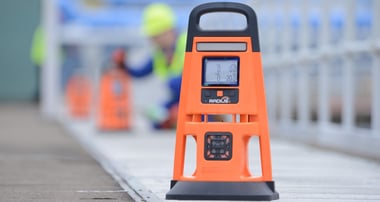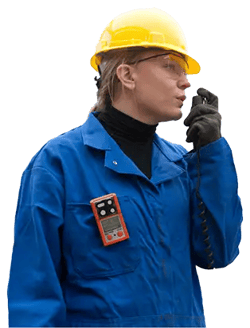 Chlorine gas (Cl2) plays a crucial role in various industrial applications, from water treatment to chemical manufacturing. Due to its toxic nature, understanding and monitoring Cl2 gas levels is essential for ensuring not only the safety of your employees, but that you’re also staying in compliance.
Chlorine gas (Cl2) plays a crucial role in various industrial applications, from water treatment to chemical manufacturing. Due to its toxic nature, understanding and monitoring Cl2 gas levels is essential for ensuring not only the safety of your employees, but that you’re also staying in compliance.
In this blog, we’ll highlight the importance of chlorine in industrial environments, the potential hazards associated with Cl2, best practices for monitoring chlorine, and tips on choosing an effective Cl2 gas detection system.
What is Chlorine (Cl2) Gas?
Cl2 is a highly reactive, yellow-green gas with a pungent odor. It is commonly used in the production of paper, textiles, and a multitude of chemicals, as well as in water and wastewater treatment plants to disinfect and purify water. Despite its widespread use, chlorine is a hazardous substance that can cause severe health issues if not handled properly.
Chlorine Applications by Industry
- Water Treatment: Chlorine is extensively used for disinfecting drinking water and treating wastewater. It effectively kills bacteria, viruses, and other pathogens, ensuring safe water for consumption and reducing the risk of waterborne diseases.
- Chemical Manufacturing: Chlorine is a key ingredient in producing many chemicals, including hydrochloric acid, PVC, and various solvents.
- Paper and Textile Industry: Chlorine is used in the bleaching process to whiten paper and textiles.
Hazards of Chlorine (Cl2) Gas
While chlorine is critical in many industrial processes, it poses several health risks:
- Respiratory Issues: Inhalation of chlorine gas can cause coughing, shortness of breath, and chest pain. Prolonged exposure may lead to chronic respiratory problems or even death.
- Skin and Eye Irritation: Chlorine gas can cause severe irritation and burns to the skin and eyes.
- Environmental Impact: Chlorine can react with organic compounds in the environment, forming toxic by-products that can harm wildlife and ecosystems.
Monitoring Chlorine Levels in Industrial Environments
Given the risks associated with Cl2 gas, it’s critical to implement not only an effective gas monitoring system, but an effective safety program. Typical best practices can include:
- Cl2 Detectors: Add personal and area gas monitors with peer-to-peer communications to continuously monitor Cl2 levels. Ensure they are calibrated regularly for accurate readings.
- Regular Inspections: Conduct routine inspections of storage and handling areas to detect leaks or other potential hazards.
- Employee Training: Educate employees on the dangers of chlorine gas, proper handling procedures, and emergency response protocols. Practice these protocols frequently.
- Ventilation Systems: Implement robust ventilation systems to prevent the accumulation of chlorine gas in confined spaces. Plus, add area monitors with Modbus and relay control to connect to your ventilation systems.
- Emergency Response Plan: Develop and maintain a comprehensive emergency response plan to address potential chlorine gas leaks or spills. Continue to practice these protocols.
Cl2 Detection Methods
 Effective chlorine gas monitoring relies on advanced detection methods. Here are some primary types of Cl2 detection systems:
Effective chlorine gas monitoring relies on advanced detection methods. Here are some primary types of Cl2 detection systems:
- Portable Monitors: Personal safety devices like the Ventis Pro5, which can be carried by workers in areas where Cl2 might be present, are one option. They provide immediate alerts to the individual, in case of gas exposure. With peer-to-peer communication features, these monitors can also alert other workers in the vicinity, so everyone is aware of the hazard present.
- Fixed Point Detectors: Portable area monitors, such as the Radius BZ1 Area Monitor, can be placed at strategic locations where Cl2 release is likely. Area monitors like this offer continuous monitoring and, with relay control and Modbus capabilities, can be networked to central control systems for a comprehensive view of Cl2 levels across the facility.
Tips on Choosing an Effective Cl2 Gas Detection System
Selecting the right Cl2 gas detection system is crucial for ensuring workplace safety. Consider the following tips when choosing a detection system:
- Sensitivity and Accuracy: Choose a detector that can accurately measure low levels of chlorine gas, as even small concentrations can be hazardous.
- Response Time: Look for a system with a fast response time to quickly identify and address leaks or high chlorine levels.
- Durability and Reliability: Ensure the detection system is robust and reliable, particularly if it is used in harsh industrial environments.
- Ease of Use and Maintenance: Select a system that is user-friendly and requires minimal maintenance. Regular calibration should be straightforward to ensure ongoing accuracy.
- Compliance with Regulations: Verify that the detection system complies with relevant industry standards and safety regulations.
- Integration with Safety Systems: Consider detectors that can integrate with your existing safety systems, such as alarms and ventilation controls, for a comprehensive safety solution.
Training and Awareness
Even with the best Cl2 gas monitors, they aren't effective unless workers know how to use them properly. Regular training sessions should be held to ensure that all personnel are familiar with the operation, maintenance, and response procedures associated with any Cl2 gas detection system. Workers should also be educated on the potential sources and properties of chlorine gas to foster a culture of safety and awareness. Some potential safety protocols to train users on include:
- Conducting Risk Assessments: Teach workers how to conduct risk assessments for Cl2 exposure to identify and mitigate potential hazards.
- Implementing Engineering Controls: Train employees on how to implement engineering controls to minimize Cl2 release and exposure.
- Ensuring Proper Ventilation: Educate workers on the importance of proper ventilation in areas where chlorine gas may be present.
- Using Personal Protective Equipment (PPE): Provide training on the correct use of PPE, including respirators, to protect against chlorine exposure.
- Recognizing and Responding to Cl2 Exposure: Ensure that workers know how to recognize the signs of Cl2 exposure and the appropriate response actions, including evacuation and first aid procedures.
Conclusion
Chlorine (Cl2) gas is an essential component in many industrial processes, but its hazardous nature necessitates vigilant monitoring and safety measures. By understanding the properties and risks of Cl2, implementing effective monitoring practices, and ensuring thorough training and awareness, industries can ensure the safety of their workers and the surrounding environment.
For more information on Cl2 safety and monitoring solutions and to ensure your workplace remains a safe environment for all, reach out to our industry experts here.



